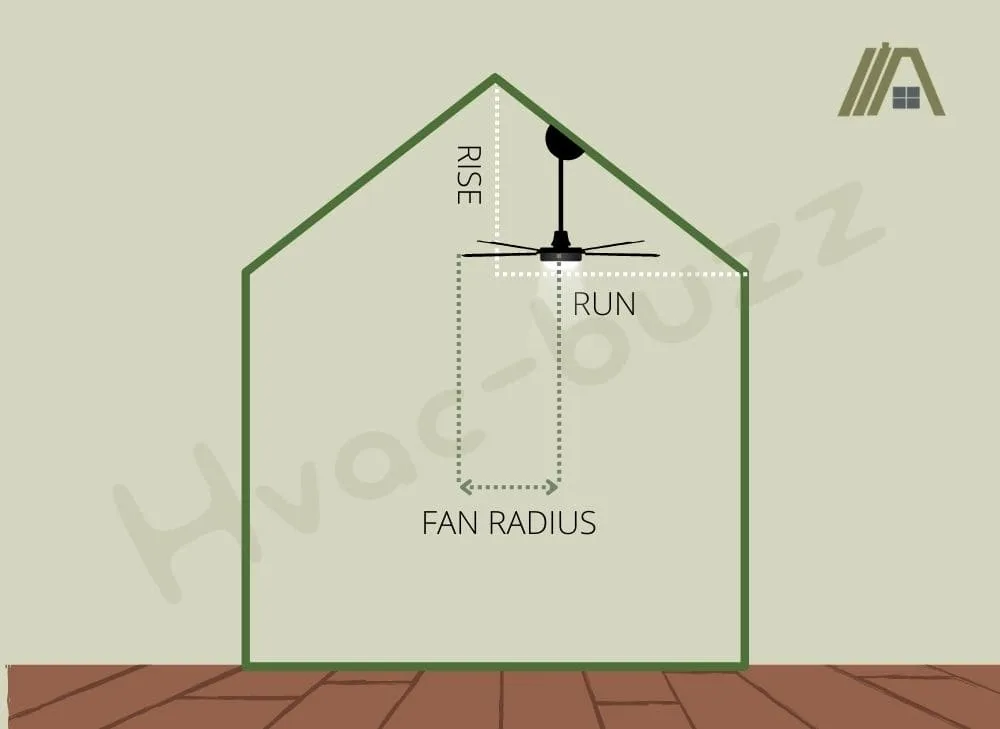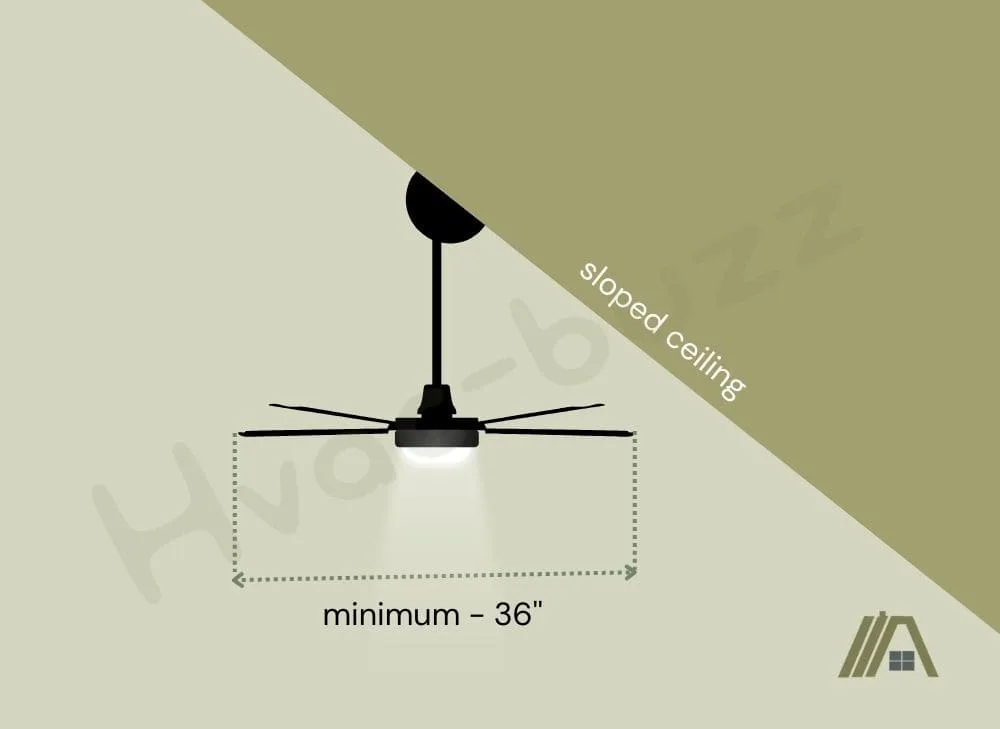Installing a ceiling fan on a sloped ceiling can seem like a really tricky task. Obviously, a downrod is required, but figuring out what length will ensure the fan works without scraping against the lower part of the ceiling needs to be worked out.
Now, working it out is not that difficult, as you will see, but charts and tables are always easier, so we’ve compiled a list of downrod lengths for various ceiling slope angles and fan sizes.

To calculate the length of the down rod, divide the rise by the run, multiply by the fan’s radius, and add four.
The Goals
When installing ceiling fans on sloped ceilings, the main goal is to hang the fan at a functional height without the blades coming into contact with the lower side of the ceiling.
In terms of the functional height, we are aiming for 8-9′ as measured from the floor to the underside of the ceiling fan blades.
Lower than this is a safety risk. Higher means that the effectiveness of the fan is diminished.
In terms of the distance from the sloped ceiling, we are aiming for about 10-12″ as measured from the top of the ceiling fan blades to the lowest point of the ceiling above the blades.
Increasing this distance will impact how well the fan functions in winter mode. Decreasing the distance will increase turbulence and, therefore, increase noise and reduce efficiency.
Calculating Downrod Length
The angle is important to the right length of a downrod for a sloped ceiling. As you can imagine, the steeper the angle, the longer the downrod will need to be in order to ensure that the blades are far enough away from the lowest point of the ceiling.
However, when it comes to calculating the downrod length, you only need to know three dimensions:
- The rise
- The run
- The fan radius

The Rise
The rise is the vertical distance between the highest point of the ceiling and the lowest point of the ceiling.
The average maximum height of a vaulted or cathedral ceiling is 13′. The average lowest height of a wall (this will also be the lowest point of the ceiling) is 7′.
This is defined by the International Residential Code in Section R305.1 as the lowest allowable ceiling height for habitable rooms.
This means, that our possible rise options, kept to whole numbers, are 6′, 5′, 4′, 3′, and 2′.
We are going to leave out the last foot because if the lowest ceiling height is 7’, then another foot make it 8′ at the highest point. This is the lowest that a ceiling fan should hang in order to function properly.
So, if your ceiling is only 8′ high, then you have to forfeit a fan or go for a really slim flush mount model.
The Run
The run is the horizontal distance between the highest and lowest points of the ceiling.
The minimum distance between the fan blades and the wall is 18″, which is 1.5’.
In terms of our parameters for the possible runs, we need at least another 36” (3’) to account for the width of the fan. This totals to 4.5’.
We are only going to go up to 10′ because that’s about half the length of a large living room in the USA.
This means that our possible run options are 4.5′, 5′, 6′, 7′, 8′, 9′, and 10′.
The Fan Radius
Let’s be honest, if you have a vaulted ceiling, you are not going to choose a very small ceiling fan. So, let’s make our smallest fan size 36” (this is also why we chose it when setting the parameters for the run).

You get a wide variety of fan sizes, but let’s stick to the more common ones for the sake of simplification.
The fan sizes that we will be considering in this article are 36″, 42″, 48″, 52″, 60″, and 72″. This means that the radii we will be working with are 18″, 21″, 24″, 26″, 30″, and 36”.
Adaptors
Before we get to the chart, you should note that if your ceiling slope exceeds about 30°, then you will likely need to purchase an adaptor that allows the downrod to hang straight while installed at that angle.
Why only after 30°? Well, many fans are actually designed to handle angled installation up to this average angle.
Ceiling fan downrods are not universal, so keep that in mind if you are looking to purchase a longer one for sloped ceiling installation.
Chart of Downrod Lengths for All Slopes
We have used all the rise, run, and fan radius combinations to create the following table.
The rise and run were used to calculate the slope angle according to tan(A) = opposite/adjacent.
Downrod calculation is 4 + (ceiling fan radius x rise/run)
| Angle (°) | Fan Radius (inches) | Downrod Length (inches)* |
| 53 | 18 | 28 |
| 53 | 21 | 32 |
| 53 | 24 | 36 |
| 53 | 26 | 38.67 |
| 53 | 30 | 44 |
| 53 | 36 | 52 |
| 50 | 18 | 25.6 |
| 50 | 21 | 29.2 |
| 50 | 24 | 32.8 |
| 50 | 26 | 35.2 |
| 50 | 30 | 40 |
| 50 | 36 | 47.2 |
| 48 | 18 | 24 |
| 48 | 21 | 27.33 |
| 48 | 24 | 30.67 |
| 48 | 26 | 32.89 |
| 48 | 30 | 37.33 |
| 48 | 36 | 44 |
| 45 | 18 | 22 |
| 45 | 21 | 25 |
| 45 | 24 | 28 |
| 45 | 26 | 30 |
| 45 | 30 | 34 |
| 45 | 36 | 40 |
| 42 | 18 | 20 |
| 42 | 21 | 22.67 |
| 42 | 24 | 25.33 |
| 42 | 26 | 27.11 |
| 42 | 30 | 30.67 |
| 42 | 36 | 36 |
| 41 | 18 | 19.43 |
| 41 | 21 | 22 |
| 41 | 24 | 24.57 |
| 41 | 26 | 26.23 |
| 41 | 30 | 29.71 |
| 41 | 36 | 34.86 |
| 40 | 18 | 19 |
| 40 | 21 | 21.5 |
| 40 | 24 | 24 |
| 40 | 26 | 25.67 |
| 40 | 30 | 29 |
| 40 | 36 | 34 |
| 39 | 18 | 18.4 |
| 39 | 21 | 20.8 |
| 39 | 24 | 23.2 |
| 39 | 26 | 24.8 |
| 39 | 30 | 28 |
| 39 | 36 | 32.8 |
| 37 | 18 | 17.5 |
| 37 | 21 | 19.75 |
| 37 | 24 | 22 |
| 37 | 26 | 23.5 |
| 37 | 30 | 26.5 |
| 37 | 36 | 31 |
| 36 | 18 | 16.86 |
| 36 | 21 | 19 |
| 36 | 24 | 21.14 |
| 36 | 26 | 22.57 |
| 36 | 30 | 25.43 |
| 36 | 36 | 29.71 |
| 34 | 18 | 16 |
| 34 | 21 | 18 |
| 34 | 24 | 20 |
| 34 | 26 | 21.33 |
| 34 | 30 | 24 |
| 34 | 36 | 28 |
| 32 | 18 | 15.25 |
| 32 | 21 | 17.13 |
| 32 | 24 | 19 |
| 32 | 26 | 20.25 |
| 32 | 30 | 22.75 |
| 32 | 36 | 26.5 |
| 31 | 18 | 14.8 |
| 31 | 21 | 16.6 |
| 31 | 24 | 18.4 |
| 31 | 26 | 19.6 |
| 31 | 30 | 22 |
| 31 | 36 | 25.6 |
| 30 | 18 | 14.29 |
| 30 | 21 | 16 |
| 30 | 24 | 17.71 |
| 30 | 26 | 18.86 |
| 30 | 30 | 21.14 |
| 30 | 36 | 24.57 |
| 29 | 18 | 14 |
| 29 | 21 | 15.67 |
| 29 | 24 | 17.33 |
| 29 | 26 | 18.44 |
| 29 | 30 | 20.67 |
| 29 | 36 | 24 |
| 27 | 18 | 13 |
| 27 | 21 | 14.5 |
| 27 | 24 | 16 |
| 27 | 26 | 17 |
| 27 | 30 | 19 |
| 27 | 36 | 22 |
| 24 | 18 | 12 |
| 24 | 21 | 13.33 |
| 24 | 24 | 14.67 |
| 24 | 26 | 15.56 |
| 24 | 30 | 17.33 |
| 24 | 36 | 20 |
| 23 | 18 | 11.71 |
| 23 | 21 | 13 |
| 23 | 24 | 14.29 |
| 23 | 26 | 15.14 |
| 23 | 30 | 16.86 |
| 23 | 36 | 19.43 |
| 22 | 18 | 11.2 |
| 22 | 21 | 12.4 |
| 22 | 24 | 13.6 |
| 22 | 26 | 14.4 |
| 22 | 30 | 16 |
| 22 | 36 | 18.4 |
| 21 | 18 | 10.75 |
| 21 | 21 | 11.88 |
| 21 | 24 | 13 |
| 21 | 26 | 13.75 |
| 21 | 30 | 15.25 |
| 21 | 36 | 17.5 |
| 18 | 18 | 10 |
| 18 | 21 | 11 |
| 18 | 24 | 12 |
| 18 | 26 | 12.67 |
| 18 | 30 | 14 |
| 18 | 36 | 16 |
| 17 | 18 | 9.4 |
| 17 | 21 | 10.3 |
| 17 | 24 | 11.2 |
| 17 | 26 | 11.8 |
| 17 | 30 | 13 |
| 17 | 36 | 14.8 |
| 16 | 18 | 9.14 |
| 16 | 21 | 10 |
| 16 | 24 | 10.86 |
| 16 | 26 | 11.43 |
| 16 | 30 | 12.57 |
| 16 | 36 | 14.29 |
| 14 | 18 | 8.5 |
| 14 | 21 | 9.25 |
| 14 | 24 | 10 |
| 14 | 26 | 10.5 |
| 14 | 30 | 11.5 |
| 14 | 36 | 13 |
| 13 | 18 | 8 |
| 13 | 21 | 8.67 |
| 13 | 24 | 9.33 |
| 13 | 26 | 9.78 |
| 13 | 30 | 10.67 |
| 13 | 36 | 12 |
| 11 | 18 | 7.6 |
| 11 | 21 | 8.2 |
| 11 | 24 | 8.8 |
| 11 | 26 | 9.2 |
| 11 | 30 | 10 |
| 11 | 36 | 11.2 |
Sources
https://www.homedit.com/average-living-room-size/
https://www.delmarfans.com/educate/basics/how-to-calculate-the-slope-of-a-ceiling/
https://www.builderscalculator.com/ceiling-fan-downrod-length-calculator/
https://airflowacademy.com/downrod-length-for-sloped-vaulted-ceilings/

